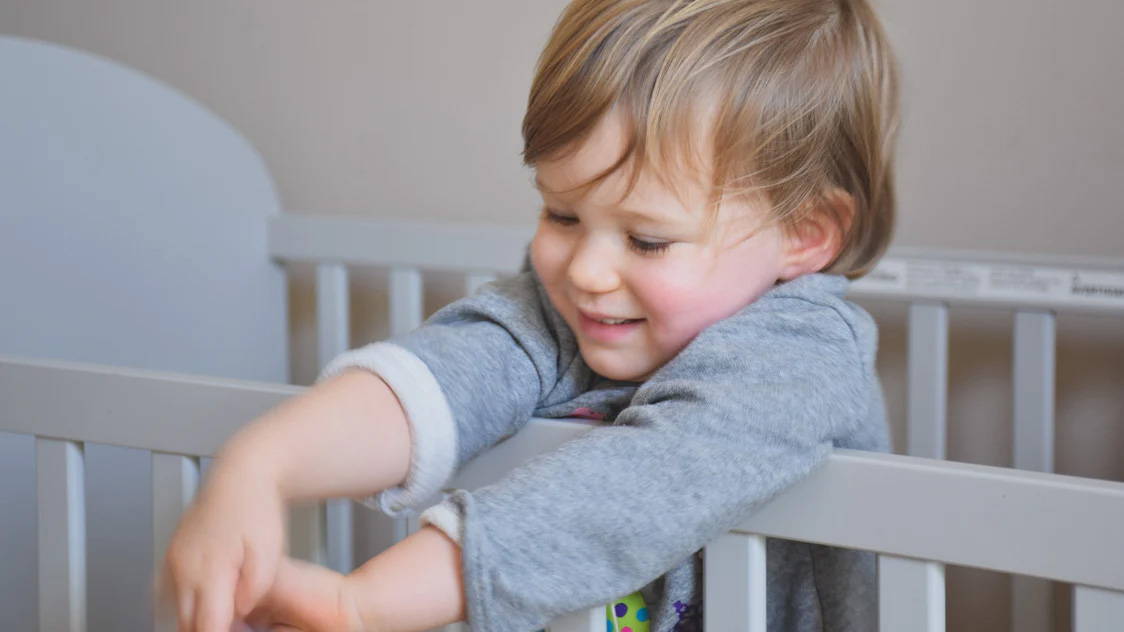
Crib Climbing: Keeping your Little "Escape Artist" Safe
| Pregnancy |
At my office, the new year is “ringing in” with a TON of phone calls from frantic parents whose toddlers are climbing out of their cribs. If you’re the parent of a crib climber I’m sure you can relate. The first time it happens is a heart stopper! One minute you’re tucking them into their crib and 5 minutes later they’re standing at the top of the stairs! Crib climbing is scary, especially if you’re worried that your child is going to hurt themselves when they try.
If you’ve read my FCMB article on cribs vs big kid beds you already know that I strongly recommend keeping children in their cribs until they’re at least 2.5 or 3 years of age. Younger children simply don’t have the cognitive ability to understand what “stay in bed all night long” means! The freedom of a bed and a toddler’s lack of impulse control is a brutal combination that can not only lead to difficult bedtimes – it can be downright dangerous if they decide to wander around in the middle of the night.
If your child has started crib climbing you may think that switching to a bed is your only option. Don’t jump to that conclusion right away! With patience and consistency even very determined climbers can be taught to stay in their crib.
LOWER THE MATTRESS
This may seem obvious, but make sure that your child’s mattress is lowered as far as it can go. For smaller children this may be all it takes to stop them from making it over the rail.
LOOK AT YOUR CHILD’S SCHEDULE
As toddlers get older their sleep needs change – bedtime usually shifts by about an hour later sometime in the 2nd year. If you’re putting your child to bed before they’re biologically ready to sleep they’re much more likely to be bored – and that’s a set up for crib climbing.
To minimize awake time, keep a sleep log for a week or so to determine the average time that your child has been falling asleep. Consider this time to be their biological bedtime and start putting them in the crib at that time instead. This may be a bit later than you’re comfortable with, but you can work back to a more appropriate bedtime once things improve. Use the same approach with naps – note the time that they typically fall asleep in the afternoon and start by put them into the crib at that time instead.
REMOVE ITEMS FROM THE CRIB THAT HELP THEM CLIMB
Stuffed animals, toys, pillows, blankets and bumpers can all serve as “stepping stones” for smart little climbers. Make sure that there’s nothing in your child’s crib that can be used to help them get their little legs up and over. Position the crib away from curtains, furniture – anything that your child can use as leverage to help them climb. If your child’s crib has a tall side, turn the crib around so that the short side is against the wall.
TRY A SLEEP SACK
Sleep sacks can help to discourage climbing by limiting your child’s ability to lift their leg up over the crib rail. (Unfortunately a sleep sack won’t stop escape artists that swing both legs over at the same time.) If your child is clever and can unzip their sleep sack and take it off, try putting it on backwards so that the zipper is in the back where they can’t reach it.
HAVE A PLAN
The safest way to discourage crib climbing is to catch your child in the act of climbing and to send a very clear message that it’s unacceptable.
To accomplish this, try using a video monitor to help you catch them before they start to climb.
When its time to sleep, kiss your child, leave the room and wait quietly in the hall with the monitor in hand. If you see signs of climbing, go back into the room immediately and say “no climbing – time to sleep” in a calm, no non-sense voice. Take a moment to resettle your child, but keep the engagement brief. Don’t force them to lay down, and don’t lay them down over and over again (it’s a battle you won’t win!) Pat the mattress, encourage them to lay down and then leave to the room, wait in the hall and repeat the process until they fall asleep.
If your child makes it out of the crib before you can get back in the room (or if they climb out on the middle of the night) simply pick them up and put them back in their crib and repeat your phrase “no climbing – time to sleep.” You may need to put them back in the crib numerous times, but after for three or four days of utter consistency you should see the behavior start to fade.
If you’re worried about safety (and especially if your child is a middle of the night explorer) you may want to sit in the room near the door at bedtime and/or sleep in the room for three or four nights. Don’t be afraid of creating new habits – “mommy or daddy sleeps with me in my room.” As they get better at understanding what’s expected you can gradually work your way out of the room.
TRY A VISUAL CUE
“Stay in your crib until morning” is a pretty vague statement for children that can’t tell time. Using a sleep clock or even an appliance timer with a lamp can provide your child with a clear signal that it’s morning. Explain to your child that until the light comes on it’s not time to get up, and that when it does light up you’ll come for them to start the day. This strategy may not be effective if your child is under age 2.5 (remember the lack of cognitive ability and impulse control I mentioned earlier?) but your two year old may grasp the concept, so it doesn’t hurt to try! Offer lots of praise when they stay put until you come – positive reinforcement is always the best way to encourage cooperation.
BE CONSISTENT!
Remember that when working on sleep behavior, consistency is the key to success. Putting your toddler back in their crib when they climb out at bedtime but allowing them to sleep in your bed when they climb out at 2:00 am is confusing and only reinforces the behavior. As tempting as it is to cave in in the middle of the night, stick to your plan all night every night. If you have a partner or spouse, take turns being on “climbing patrol” so that you both can get a decent stretch of sleep.
If after a week or two of constant intervention you’re convinced that the that no amount of discouragement is going to stop the behavior, be sure that your child’s room is completely safe before you switch out to a bed. Install a gate on your child’s door to keep them from roaming, and don’t give the crib away in case the big bed proves to be too overwhelming and you want to try for the crib again.
Sweet dreams!
Written by Alison Bevan
Alison Bevan is a Baby and Child Sleep Consultant that has helped thousands of families get a good night’s sleep. She is a Certified Gentle Sleep Coach SM, founder of Sleepytime Coach and the Pediatric Sleep Consultant at The Center For Advanced Pediatrics, one of the largest and most comprehensive pediatric practices in the tri-state area. She is also a mother that has lived through the challenges of having a child with sleep problems.



